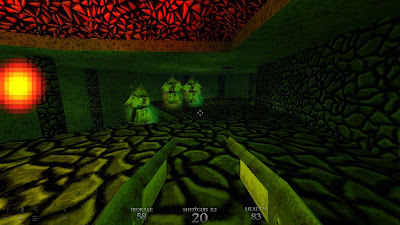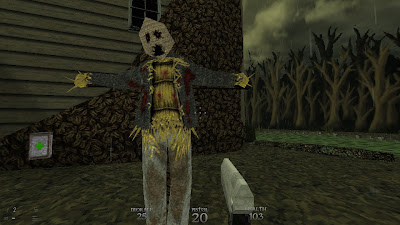They say
they don’t make them like they used to. But when they do? They make a game like
Dusk.
Tale from the Crypt
Dusk is a loving homage to the first
generation of true 3D shooters. Loud, fast, violent, playful and a bit grungy.
Graphics are deliberately low-poly, the particle effects delightfully pixelated.
The tone and aesthetic is that of a gloomy metal album cover. If Quake retired and moved out to the
country this is the grandchild of that line.
 |
| Your first lesson: MOVE |
The game gets
right to the point. You are “Dusk Dude” and you wake up on meat hooks in the
kind of basement you find people up on meat hooks in. A guttural voice growls
“Kill the Intruder” and three burly fellows wearing burlap sacks over their
heads come racing out of the dark revving chainsaws. Act fast.
Every
element of the design is deliberately, proudly old-school. You can carry every
weapon simultaneously and none need manual reloading. Movement is blisteringly
fast and mastering the bunny-hop allows for feats of tremendous speed and
agility. Enemies ignore allies in their line of fire and are quick to in-fight.
Every attack can be dodged, health does not regenerate, and falls from any
height do no harm.
 |
| Creepy Klan-esk cultists are the most common opposition. |
Dusk is not afraid to be playful either.
Most objects can be destroyed, for a brief tactical advantage or the sheer joy
of destruction. Ambiguous chunks of meat can be roasted and devoured to restore
health and beer bottles quaffed to improve morale. Crates can be stacked into
make-shift stairs and bars of soap hurled to gibb enemies on contact. Almost
everything can, of course, be flushed down a working toilet.
Spilling Blood
Combat is
happy to reward speed, precision, and aggression, though it’s certainly
possible to hang back and cheese some encounters if that’s your idea of a good
time. You’re faster than most foes and hit-scan attacks are completely absent.
Weapon switching is speedy and all are tactically useful, giving a strong
incentive to seek out the many secrets and expand your arsenal as soon as
possible.
 |
| Ludicrous gibs, like God intended. |
Weaponry is
chunky and powerful, immensely satisfying to use. The double-barreled shotgun
sounds and feels appropriately devastating. Most of your selection is workman-like,
but a magic crossbow pierces whole conga-lines of enemies and even kills
through walls. The Riveter rocket launcher can rip through even the meatiest
boss health bar (and its ammo stock) in seconds.
The campaign
is split into three acts, each with a distinctive setting and tone. In true classic
shooter fashion each is a self-contained experience (complete with secret
level) that starts you with an empty arsenal and builds to a climactic boss
fight. While there’s an obvious narrative arc and difficulty curve the acts can
be played in any order.
Passion Play
Act One has
a strong rural-horror vibe, with its quaint farmhouses and dreary woods. These
places were normal, lived-in, once. Before the force below the town warped the
minds of the inhabitants to murderous devotion and madness. The setting is
reminiscent of Build engine classic Blood,
with a hint of the distant banjos of Redneck
Rampage.
 |
| Bloody scarecrows with glowing red eyes? Perfectly safe. |
Act Two is
more industrial, militant in tone. The soldiers and scientists here were trying
to understand and harness the power they discovered, not just worship it. The
tone and setting owe much to Half-Life.
Mundane warehouses and loading-yards give way to labs where the fabric of
reality is first teased, then violently torn. Glimpses of a greater weirdness
leer through the rips.
 |
| Nice to see the old Black Mesa staff are still getting work. |
Act Three is
pure Quake, as you leave behind our
reality for an eldritch fever dream. Impossible cathedrals stand on endless
plains beneath a bloody sky. You tread the frozen surfaces of worlds where the
sun itself has been devoured. Concepts like relative size and gravity become
arbitrary. The journey becomes less physical and more metaphorical. Are these
the memories of the Dusk Dude? The dreams of a sleeping god? And at the end,
the voice of an old friend greets you.
Such Sights to Show You
While you
pick through plenty of rusty corridors and run down rooms Dusk has a real sense of spectacle, especially once you enter the
less grounded later acts. Many levels have a genuine “Wow!” moment. The sky
splitting open to reveal the scale of the underground space you inhabit. A walk
down an elevated path into an industrial meat grinder of dizzying speed and
ferocity. A crimson tornado the size of a skyscraper bearing down.
 |
| Not every in-door space is claustrophobic. |
Almost
jarringly, Dusk is more than happy to
let you treat it as a toy rather than a carefully curated experience. The game
is a speed-runners delight, its only demand that you reach the level exit.
Whether you do that by carefully combing the level for every secret, item, and
enemy or get there in thirty seconds through a cunning combination of bunny
hopping, prop manipulation, and rocket jumping is up to you. Even bosses can be
neatly side-stepped, with bonus achievements for finishing a level without
killing anything. (Or killing everything.)
Feel the Noise
Dusk owes its atmosphere to strong environmental
design and sound work. The game is far more action that horror, but there are
effective quieter moments amid the carnage. Moving through gloomy autumnal
woods to skittering dried leaves like claws down your spine. Creeping through
catacombs with a broken flashlight while the gurgling gasps of unseen horrors
fill the darkness. Slower, tenser sections never wear out their welcome, but do
much to pace game-play.
 |
| The witching hour |
The music is
just about perfect, plenty of thumping aggressive guitar supporting the grimy
industrial synth and crunchy metal. It’s by Andrew Hulshult, a man making a
well-earned name for himself in classic shooter soundtracks. Give this sample a
listen.
While the campaign
is the reason to buy the game, the “Duskworld” multiplayer is a more than
welcome addition. As expected from a game taking its cues from Quake, map control and mastery of
movement are the keys to victory. If you’re not bunny hopping to build speed at
all times you’re doing it wrong. An endless wave based horde mode rounds out
the feature list.
Reasons
to Play: Excellent old-school true 3D shooter design. Three episodes of
escalating gameplay challenge and creative mapping. High speed Quake-style death-matching.
Reasons
to Pass: Allergy to low polygon counts.
Articles copyright James Cousar, games and images copyright their respective owners.

No comments:
Post a Comment